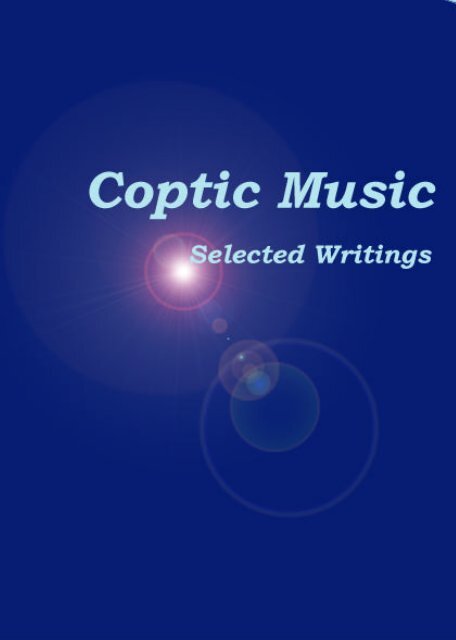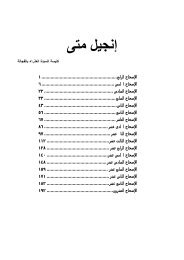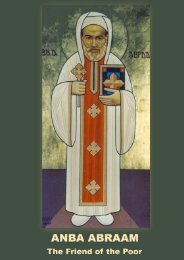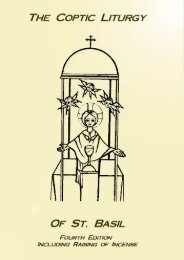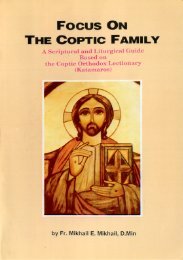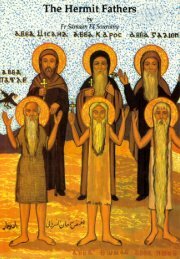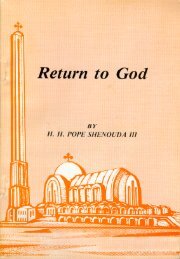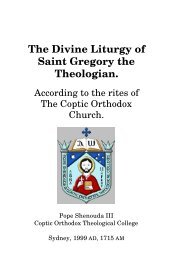COPTIC MUSIC - Saint Mary Orthodox Church
COPTIC MUSIC - Saint Mary Orthodox Church
COPTIC MUSIC - Saint Mary Orthodox Church
- No tags were found...
Create successful ePaper yourself
Turn your PDF publications into a flip-book with our unique Google optimized e-Paper software.
Coptic Music<br />
Selected Writings
Our Lord and Saviour Jesus Christ King of Kings and<br />
Lord of lords<br />
2
THE BEHOLDER OF GOD<br />
MARK THE EVANGELIST<br />
SAINT AND MARTYR<br />
3
H.H. Pope Shenouda III, 117th Pope of<br />
Alexandria and the See of St. Mark<br />
4
Coptic Music: Value and<br />
Origins<br />
By: Ragheb Moftah Habashy<br />
Article by: Ragheb Moftah Habashy, Head of the Coptic<br />
Music Department, Coptic Studies Institute, Cairo, Egypt<br />
(1958)<br />
In the Name of the Father the Son & the Holy Spirit<br />
One God Amen.<br />
Music elevates the spirit. It takes it from this tangible<br />
materialistic world towards the intangible spiritual world. Art<br />
in general and music in particular fleshes out what is<br />
spiritual. It is the medium between spirituality and our<br />
material life. Every beauty in nature shows elevation and<br />
every artistic inspiration demonstrates a level of elation.<br />
Music is not fantasy or distraction; it is part of life<br />
and one of its most important elements. Musical talents are<br />
in each one of us. Some have the strength to express it and<br />
others have the strength to feel it, enjoy it, and be touched by<br />
it.<br />
The best instrument ever is the human's voice. People<br />
used vocal music since their very early existence on earth. It<br />
has no substitute. All mothers, starting with Eve, sing in<br />
order to calm down their babies. The songs or tunes may<br />
differ, but they have one source: Motherly love.<br />
For thousands of years, people used music in worship<br />
to praise their creator. They used music when working in<br />
5
prairies and over hills and mountains, when building their<br />
houses, when traveling down rivers or across oceans. Music<br />
is not just a combination of beautiful sounds that pleases the<br />
ear; it is an essential nourishment of the soul. Food might<br />
taste good, but the purpose of food is the nourishment of the<br />
body. Similarily, I won't be exaggerating when I say that<br />
music's purpose is the nourishment of the spirit.<br />
The Old Testament tells us that musical arts existed<br />
from the very early existence of humans. In Genesis 4:21, we<br />
learn of Jubal son of Lamek of the 9th generation from<br />
Adam. He was the father of all harpists and organists.<br />
When Moses and the Israelites crossed the Red Sea,<br />
Exodus tells us how "[they sang] this song unto the LORD,<br />
and spake, saying, I will sing unto the LORD, for he hath<br />
triumphed gloriously... And Miriam the prophetess, the sister<br />
of Aaron, took a timbrel in her hand; and all the women went<br />
out after her with timbrels and with dances. And Miriam<br />
answered them, Sing ye to the LORD, for he hath triumphed<br />
gloriously; the horse and his rider hath he thrown into the<br />
sea." [Exodus 15:1,21] Also in Judges we read: "Then sang<br />
Deborah and Barak the son of Abinoam on that day, saying,<br />
Praise ye the LORD for the avenging of Israel, when the<br />
people willingly offered themselves. Hear, O ye kings; give<br />
ear, O ye princes; I, even I, will sing unto the LORD; I will<br />
sing praise to the LORD God of Israel." [Judges 5:1-3]. And<br />
during the prophet David's time, music reached its fullness in<br />
poetry, melodies and performances. Music was an essential<br />
part of all their praises to their creator, their prayers in times<br />
of war and in times of peace, theirin times of joy and and in<br />
times of sorrow.<br />
In Chronicles we read: "It came even to pass, as the<br />
trumpeters and singers were as one, to make one sound to be<br />
heard in praising and thanking the LORD; and when they<br />
lifted up their voice with the trumpets and cymbals and<br />
6
instruments of musick, and praised the LORD, saying, For he<br />
is good; for his mercy endureth for ever: that then the house<br />
was filled with a cloud, even the house of the LORD." [2-<br />
Chronicles 5:13].<br />
With this artistical splendeur, the Spirit came along,<br />
and with the strengh and influence of music immobile<br />
materials were moved, and Jericho's walls fell down.<br />
This is the status of art in worship it arrived to it's optimum..<br />
How beautiful are Psalms!!.. People still enjoy them until this<br />
day.. They were written by the best ever mentioned psalters..<br />
And Isaiah says in Isa 6:1-4: I saw also the Lord<br />
sitting upon a throne, high and lifted up, and his train filled<br />
the temple. Above it stood the seraphims: each one had six<br />
wings; with twain he covered his face, and with twain he<br />
covered his feet, and with twain he did fly. And one cried<br />
unto another, and said, Holy, holy, holy, is the LORD of<br />
hosts: the whole earth is full of his glory. And the posts of<br />
the door moved at the voice of him that cried, and the house<br />
was filled with smoke.<br />
The church on earth tries to imitate the Heavenly<br />
<strong>Church</strong>.. The Revelation Book says that all heavenly hosts<br />
despite their different classes praise around God's throne and<br />
in His house day & night saying the Trisagion and reply<br />
saying that to Him be Power & Wisdom & Strengh &<br />
Honour & Glory & Blessing for all things were created by<br />
Him.. And Rev 5:8-9 says And when he had taken the book,<br />
the four beasts and four and twenty elders fell down before<br />
the Lamb, having every one of them harps, and golden vials<br />
full of odours, which are the prayers of saints. And they sung<br />
a new song, saying, Thou art worthy to take the book, and<br />
to open the seals thereof: for thou wast slain, and hast<br />
redeemed us to God by thy blood out of every kindred, and<br />
tongue, and people, and nation.<br />
This is life in heaven.. One hymn on heaven will<br />
7
exceed all earthly hymns together in beauty.. That will be our<br />
life in the New Jerusalem coming from heaven..<br />
(There the Chorus sang the Bright Saturday Response on<br />
the Revelation reading: If you have ears, then listen to what<br />
the Spirit says to the <strong>Church</strong>es!)<br />
How beautiful are the tunes of these few verses of<br />
the Bible: And suddenly there was with the angel a multitude<br />
of the heavenly host praising God, and saying, Glory to God<br />
in the highest, and on earth peace, good will toward men. I<br />
think that however great & profound our imagination is, we<br />
can never realise how beautiful these tunes were..<br />
I think it became clear why Apostolic <strong>Church</strong>es did<br />
take a big amount of music in it's services & dogmas over the<br />
whole year.. Specially the Coptic <strong>Church</strong> where almost each<br />
word during the whole year whether in the morning or<br />
evening is chanted..<br />
Here is the Apostolic teaching.. St.Paul speaks to<br />
Christians in his letter to Ephesians.. Eph 5:19-20 Speaking<br />
to yourselves in psalms and hymns and spiritual<br />
songs,singing and making melody in your heart to the Lord;<br />
And in his letter to Colosians.. Col 3:16 Let the word of<br />
Christ dwell in you richly in all wisdom; teaching and<br />
admonishing one another in psalms and hymns and spiritual<br />
songs, singing with grace in your hearts to the Lord...<br />
St.John Christosomos explains that "singing with grace in<br />
your hearts".. Also Origen, St.Basil, St.Augustin among<br />
others explained these verses clearly.. It was clear from that<br />
letter to Clossians that St.Paul was referring to <strong>Church</strong><br />
Prayers which were well known to the readers.. From both<br />
texts, it is clear that St.Paul made music an essential element<br />
of worship and divided it to three: Psalms-Praises-Spiritual<br />
songs which are hymns.. These three parts were the<br />
8
fundamentals on which all traditional churches: Oriental &<br />
Occidental based their prayers.. If anyone objects on<br />
Apostolic <strong>Church</strong>es we may say that the base is in the Bible..<br />
(Here a University Female Chorus sang the 'Big Fast' Hymn<br />
: Apenchois)<br />
The early Christian Congregation began in<br />
Jerusalem.. It did attend both the synagogue & the temple..<br />
Several texts in the Acts book mentioned that.. Among<br />
which Acts 3:1 Now Peter and John went up together into<br />
the temple at the hour of prayer, being the ninth hour..<br />
Although the temple's music was instrumental, the<br />
synagogue's music was vocal.. So, when the first christians<br />
became independent, they took their musical rites from the<br />
synagogue and used only vocal singing.. Composers &<br />
Readers who left Judaisme & believed in Christianity used to<br />
have the same job in Christianity.. So, Psalms were chanted<br />
exactly the same way they were sung in synagogues..<br />
As the early Jerusalem's <strong>Church</strong> the music was vocal<br />
in all Oriental & western churches.. Also, it used the same<br />
Jewish way of psalm chanting in most cases as the Jewish<br />
Christian church.. That what was said by fathers: Apostles<br />
did transmit something from the Jewish dogmas & traditions<br />
to all lands..<br />
With the beginning of Christianity, in every oriental<br />
or western country, raised prayers, liturgies & dogmas<br />
conforming with the nature & environment of each land also<br />
every land composed the music conforming with it's own<br />
taste so the Byzantine <strong>Church</strong> Music is Byzantine, the<br />
Egyptian <strong>Church</strong> Music is Egyptian, the Jewish the same..<br />
The best example for that is that the Ethiopian <strong>Church</strong><br />
although conceived and affiliated to the Egyptian <strong>Church</strong> for<br />
long generations remained pure Ethiopian.. That means that<br />
9
the local inherited art had the biggest influence in forming the<br />
<strong>Church</strong> Art..<br />
(Here an Ethiopian Chorus sang an Ethiopian Hymn)<br />
That shows a big evidence on the difference between<br />
Coptic & Ethiopian Hymns.<br />
So every nation took from it's previous worship tunes<br />
which were found appropriate. So undoubtedly, Greeks took<br />
from their ancient worship hymns and used it in Christianity..<br />
Also Romans took from their Ancient war Music & used it<br />
and so did Egyptians..<br />
Once St.Mark came to Alexandria, Inianos' family<br />
was baptised and Christianity spread quickly in all Northern<br />
& Southern Egypt in the first & second generations.. In year<br />
400 the Anas-Elwogood Island had a church and a<br />
monastery.. Scientists agreed that no population believed in<br />
Christianity in strength & zeal as the Egyptians did.. The<br />
Ancient Egyptian man did in vain search for the unseen<br />
creative strength in the soul & spirit.<br />
The most important tradition for the Ancient<br />
Egyptian City was art.. As the Ancient Egyptian arts were<br />
profoundly engraved in the people's heart, it appeared clearly<br />
in Architecture, Sculpture and Ornaments.. Very influenced,<br />
almost the same as the Ancient Egyptian with a compromise<br />
with the new positions & thoughts of Christianity in the first<br />
four generations where Christianity Hypostasis & basics<br />
were founded..<br />
Let's have a look at Ancient Egypt's art the land<br />
which believed in Christianity.. Pithagorus, the Greek<br />
scientist visited Egypt after 520 BC during the Hellenic<br />
invasion to Egypt.. their pressure and destruction to all<br />
civilisation & troubled social life.. He said that he could<br />
gather from Egypt elements on which he based his well<br />
known musical theory!!<br />
10
Singing & Music was necessary at every Ancient<br />
Egyptian festival.. No meetings lacked music.. Also women<br />
in every house, mastered music & practised it.. In the<br />
pharaoh's Palace there existed Musical teams or bands with<br />
singers they had conductors which were proud that they fill<br />
the pharaoh's heart with joy & can realise His wants with<br />
their beautiful singing..<br />
Religious Festivals were real wonder and Glory when<br />
they move with the God in his ship over the priest's<br />
shoulders in the temple.. People used to present their<br />
offerings and salutations.. These customs were usually<br />
accompanied by Musical & Singer groups.. Many of the<br />
religious liturgies were accompanied by music.. Also kingly<br />
marches were lead by priests with praises & incense many of<br />
the priests were called Psaltos Priest.. Or King singer<br />
priests.. The Egyptian People is a very rich civilisation since<br />
old times.. Yet some of ancient words are said in Labours'<br />
songs and a song to Nile's Sailors sung in Arabic exactly in<br />
it's same Ancient Egyptian pronunciation which is:"Ya Tera<br />
Tiri we hatili..."<br />
Egyptians usually preferred to use blind singers..<br />
There were many and the Coptic <strong>Church</strong> still chooses it's<br />
cantors among blinds.. But we should take care and choose<br />
only the talented ones..<br />
The Alexandria Library responsible " Dimetrios the<br />
Valerion" in 297 BC said that in their Honour & Intercession<br />
festivals for Gods Egyptian Priests used to sing on the 7<br />
Greek vowels consecutively.. It produced beautiful sounds<br />
which satisfied them from using the Flute or Harp.. Nikomax<br />
the Mathematician who lived in the first century said the 7<br />
vowels were special to the seven stars.. Until today, most of<br />
the Coptic Hymns are sung on these vowels.. Some are sung<br />
on Alpha (a) others on (e) as aretenshonty, the Big Alleluia<br />
and the Offering Alleluia.. Ancient Egyptians considered that<br />
11
singing with these vowels represented the most profound<br />
religious expression..<br />
(The Chorus sang the Offering Alleluia)<br />
Philo, the Alexandrian Jewish Philosoph who lived in the first<br />
century said:<br />
"The first Christians took from the Ancient Egyptian Hymns<br />
& used it in their new worship" Whether they took it as is,<br />
adding a spiritual dimension or didn't take it, the Egyptian<br />
Art was still living and was still Egyptian Flesh & Blood..<br />
The Singary tune was named after Singar a city in the delta<br />
since Ramses II which became famous in the Coptic Aera for<br />
the numerous monasteries which were there around and it's<br />
church were 2 consequential Popes were chosen..<br />
The Edriby Tune is probably named after Edribah the<br />
City whose Ancient temple was changed by Abba Shenuti to<br />
a church.. Copts used also to find a relation with the Coptic<br />
word "Eder Hipi" which means sorrowful..<br />
The text for hymn of the Cross: "When King<br />
Costantine's peace letters arrived Alexandria saying close the<br />
Baraby doors & open the churches" this hymn was written<br />
for the discovery of the Cross of our Lord Jesus Christ in<br />
326.. Many other hymn share this same tune with this one<br />
among which the Shaaneen Sheres & Tarh and the Cross<br />
Tarh Hymn.. That proves that these hymns are old..<br />
Among the oldest hymns, one written by St.Clement<br />
of Alexandria in 180 in his book "Paedagogus" (the<br />
teacher).. It is a thanksgiving for Christ recited by new<br />
baptised people for their salvation from the seas of sins its<br />
translation is:"Holder of the wild animals, wing of the young<br />
birds, director of peace for ships, shepherd of kingly lambs,<br />
gather Your poor children to praise in holiness and sing in<br />
honesty with sincere mouths the Christ leader of children..<br />
12
Jesus human's salvation, the Vineyard Shepherd, the<br />
heavenly help and the Holy sheep" No wonder that this hymn<br />
is no longer in use since our fathers wrote hundreds of<br />
hymns<br />
The Oldest Christian hymn transcribed with musical<br />
signs was found on a Papyrus in Bahnasa.. Coming from the<br />
ends of the 3rd century it is a trisagion musically deciphered<br />
by Prof.Phales among which:"Let all forces praise the Father,<br />
the Son and the Holy Spirit the only giver to good people<br />
Amen"<br />
(Here sang Monsieur Youanidy the Hymn with the musical<br />
note and his pure voice)<br />
This Papyrus is a very important one.. It is not like<br />
any of the thousands of old Coptic Papyrus available in<br />
Egypt & in the whole world.. Some of them return back to<br />
the 9th Century & of course copied from older copies (Many<br />
of them are concerned with music) Nothing has any musical<br />
sign except in one Papyrus in John Rylands Library,<br />
Manchester Collection.. Mr.Crum the Coptic Language<br />
scientist used some specialists to decipher those signs but<br />
they could never do it.. I hope Prof.Phales will arrive to a<br />
decision in this matter.<br />
Coptic Hymns were transmitted as oral tradition from<br />
one generation to another until 1927 when I brought Prof.<br />
Newlandsmith (Composer & Ex-Prof. in London Royal<br />
Music Academy) we signed a contract to transcribe hymns<br />
and masses in Musical Note.. I will mention that in details<br />
later on..<br />
The Egyptian <strong>Church</strong> arts & dogmas began to raise<br />
with the beginning of Christianity in Egypt.. The Egyptian<br />
<strong>Church</strong> has it's own four masses never used by any other<br />
church..<br />
13
The Kyrollos Mass was written by St.Mark the<br />
Apostle himself.. Probably, this Mass' status became stable<br />
long ago before St.Kyrollos because it is very similar to<br />
St.James Mass & The Lord's Covenant Mass, the oldest<br />
liturgies.. Both St.Basil Mass & St.Gregory do share the<br />
same Awashy part with St.Kyrollos Mass that's why we think<br />
that their music also return to it.. Except those, most of<br />
St.Kyrollos Mass Music was lost.. Nothing remained except<br />
the hymn Oukoty & Ouoh Nay they are used for the Dead<br />
Mass (Requiem Mass)<br />
Concerning the St.Basil Masses, there exist 3 masses<br />
named after St.Basil.. St.Basil of Costantinople <strong>Church</strong><br />
Mass, The Syrian St.Basil Mass & St.Basil Coptic Mass (it<br />
has a Greek text).. These three differ from each other in text,<br />
dogmas & music..<br />
Certainly, the Egyptian St.Basil Mass does belong to<br />
the Egyptian <strong>Church</strong>.. It was used before the division of 451<br />
(long before St.Basil the Great).. St.Basil's Mass Music is<br />
pure Egyptian except the confession part & Confession<br />
Introduction they are Byzantine..<br />
This Byzantine part also belongs to the Egyptian<br />
<strong>Church</strong> since it has no brother in the Costantinople text<br />
except a small sentence.. Neither in the Music, nothing is<br />
similar.. The St.Basil Mass Music, whether the Coptic or the<br />
Byzantine is so beautiful and have big influence if chanted in<br />
their original tunes and with a beautiful talented voice..<br />
The Gregorian Mass also belongs to the Egyptian<br />
<strong>Church</strong> before division.. It's music also is Egyptian except it's<br />
beginning "The love of God the Father..." and the Confession<br />
are Byzantine..<br />
"The Love of God the Father" is available in both the<br />
Coptic St.Basil Mass and Byzantine St.John Christomos but<br />
still their music are VERY different.. The Gregorian Mass<br />
Music is nothing but some Big Hymns which were going to<br />
14
e lost unless I did record it several times from Mlm.Mikhail<br />
who was the only one to have known it complete.. This mass<br />
is used in Big feasts.. It's tunes are splendid and profound<br />
and have celebration influence..<br />
The Malachite <strong>Church</strong> in Egypt used these 3 masses<br />
also after the division of the <strong>Church</strong> until the 12 th century..<br />
The 4th Mass is Abba Serapion Bishop of Tomees (Tamyel<br />
Amdid) who was the disciple of St.Anthony the Great and a<br />
friend to St.Athenese the Apostolic. It was published in<br />
1894.. We have strong proof that it belongs to the church of<br />
Alexandria.. Part of it is exactly the same in St.Mark Mass..<br />
We do know nothing about it's music or use.. It seems it<br />
wasn't used widely and didn't last for long..<br />
In the writings of HH Gabriel Ben-Toreik Pope No<br />
70 we got that some people tried using different masses than<br />
the 3 known ones.. In section 26 of his writings we found:<br />
"It came to me the weak, that some people in the Southern<br />
Cities (Seiid) pray inappropriate masses different from the<br />
three we all know which are St.Basil, St.Gregory &<br />
St.Kyrollos.. I defended people who are depending on that<br />
until they come at my residence and show these masses.."<br />
(Here was played a tape in Hegmn.Morcos priest of Matayel-mahatta's<br />
voice "The Love of God the father", The<br />
Commemoration of <strong>Saint</strong>s & Tarhim)<br />
Concerning hymns, a big rich collection survived and<br />
was preserved for the <strong>Church</strong>.. Their number exceed 300 Big<br />
& Small hymn.. Most of their texts are Coptic, some are<br />
Greek.. BUT all the music IS Coptic... These hymns are<br />
Spiritual, Profound & Beautiful.. They represent the High<br />
Standard of Spiritual Literature.. The original source of these<br />
hymns is pure Musical.. Some of them do last 15 minutes &<br />
are sung over one or few words or just a short sentence..<br />
15
Some of them (only in Greek words) are in use by Malachite<br />
but have different Byzantine Music..<br />
All <strong>Church</strong> services as Tasbeha, Evening & Morning<br />
Incense Offering, Masses, Feasts & Fasts have their own<br />
hymns.. It differs accordingly to seasons.. Many Hymns are<br />
said just once a year. Which means it was composed for a<br />
special occasion.. Which proves that the Coptic <strong>Church</strong> is a<br />
very Musical One.. The Coptic Dogmas with their hymns<br />
throughout the year represent the LIFE in both the Old &<br />
New Testaments which shows CHRISTIANITY with<br />
splendid beauty in representation..<br />
The sorrowful hymns have a very strong influence..<br />
No music in the whole world is similar.. It seems that this<br />
special aspect did characterise Egypt since very old ages:<br />
Herodote who visited Egypt in 460 BC said in his book<br />
about Egypt section 79:"One thing I am wondering about,<br />
which is the source of the song called Linos.. I think it is so<br />
old there, they call it Maniros.. They say that Maniros was<br />
the only son of their very first King.. He died very young so<br />
that they sang this sorrowful song for him.. And that this<br />
song was the first one they had.." In 1933, when more than<br />
30 European Musician & Scientist heard these sorrowful<br />
songs, in the Music Conference held in Cairo, where I had<br />
the honour to be a member, a strong feeling mastered them..<br />
I will never forget the "Singing Science" Professors in the<br />
Sorbone - Paris who asked Hegmn. Morcos Shenouda to<br />
repeat the Commemoration of <strong>Saint</strong>s OVER 6 TIMES.. Also<br />
Mr.Newlandsmith said in one of his speeches: "Give me<br />
Cruzu's voice singing some Coptic Hymns and I will destroy<br />
Jericho's Walls.."<br />
These sorrowful Hymns make the earthly boundings<br />
disappear, make the soul humble some of them could destroy<br />
the Hypocrite soul who insists in living sinner!!<br />
16
(Here the chorus sang the hymn Golgotha)<br />
The Coptic joyful hymns have their very special spiritual<br />
taste.. They make us feel that the heavenly beauty is very<br />
superior to all this world's feelings.. We do believe that a<br />
hymn, sung in a talented voice and sincere soul has big<br />
influence more than dozens of words in attracting people to<br />
the Lord..<br />
(Another Chorus sang Ei Aghaby whose music is Coptic and<br />
another hymn said in the end of Resurrection Feast)<br />
Religious Hymns which where composed similar to<br />
folkloric songs played a big role in spreading heresies and<br />
also in fighting them.. By the ends of the second Century, the<br />
Syrian "Beridessane" composed 150 psalm to spread the<br />
Gnostic Heresy which he joined he and his disciples.. So<br />
St.Avraam the Syrian composed hymns to resist & oppose it<br />
and gathered Choruses of Virgins who were intended to<br />
become nuns to sing them.. Also Arios composed folkloric<br />
songs to spread his heresy.. And a lot of fathers in Egypt &<br />
Europe composed opposite hymns to resist his thoughts.. As<br />
I did mention previously, Coptic Music was transmitted<br />
orally since the beginning of Christianity until 1927 when I<br />
called the Great Professor Newlandsmith who spent eight<br />
years transcribing it from the voice of Mlm.Mikhail until the<br />
work was done in 16 volumes.<br />
In 1931, when this job came to it's middle, the<br />
renewing supporters who called themselves the Reformation<br />
Party attacked me saying that I don't want to preserve the<br />
old things.. On this same year in May, I travelled to England<br />
and gave with Mr.Newlandsmith three speeches concerning<br />
Coptic Music in the universities of Oxford, Cambridge and<br />
London.. Hundreds of Newspapers & Magazines in Europe,<br />
the States, Egypt & the Far East wrote about these<br />
17
speeches.. Fortunately, I still have all these speeches, here I<br />
show it to you.. Here on the first page an article in Oxford<br />
Newsletter: "A Great Speech added to the group of this<br />
season's speeches" These articles described Coptic Music as<br />
Very Spiritual Music Very impressive and A Great Musical<br />
Treasure..<br />
Here are the 16 volumes dear Copts would you<br />
publish them.. I don't want any personal benefit, I even don't<br />
want to write my name down there.. After that, I don't think<br />
that any group of people would lack in preserving the most<br />
important tradition he & the whole world have, the oldest<br />
musical heritage. Many scientists everywhere are waiting for<br />
the publishing of these volumes to study Coptic Music &<br />
know the Coptic musical scales.. Although great researches<br />
on Byzantine, Syrian, Gregorian Music were published, not a<br />
word in any Musical Encyclopaedia was written about<br />
Coptic Music!!<br />
I am working on recording the hymns on tapes to<br />
provide the Great Genius Prof. Phales with the recordings<br />
and transcriptions and prepare to publish them. This<br />
Professor is the one who deciphered Old Byzantine Music<br />
Transcription..<br />
Coptic Music is Not Arabic, Not Turkish, Not<br />
Byzantine & Not Western IT IS PURE ORIGINAL<br />
EGYPTIAN <strong>MUSIC</strong>.<br />
Until today, many traditional <strong>Church</strong> music is only<br />
vocal among which Coptic, Greek & Syrian.. Above<br />
mentioned Scientists and many others advised to preserve it.<br />
They said it is the biggest crime to try playing it on musical<br />
instruments for it was designed for human's voices.. Playing<br />
it on strings gives poor, cut performance which does not<br />
represent by any way the hymn itself.. Playing it on Piano (or<br />
keyboards) requires adding harmony which also is not<br />
appropriate and requires us to destroy it's basis & squeleton<br />
18
foundations.. That means destroying the <strong>Church</strong> Heritage<br />
which is considered one of the most profound <strong>Church</strong><br />
traditions.. The Greek <strong>Church</strong> also doesn't use instruments<br />
even the Cymbal & Triangle are not used there..<br />
Prof. Newlandsmith did find some few small Coptic<br />
pieces, counted on one's hand fingers which could give the<br />
same effect when played on violin as when sung (A Capella)<br />
such as the Revelation Book Response..<br />
(Here Monsieur Yoanides played it on his violin, then<br />
Mlm.Sadek Attalla sang it, both were wonderful and<br />
mastered it very well.. To show the difference, Monsieur<br />
Yoanides played the Blessing Hymn (Lahnel Baraka) which<br />
is Tenouosht.. Mlm.Sadek sang it as well.. The difference<br />
was really big & clear, which proves that these hymns<br />
should be only vocal and should never be played on<br />
instruments..)<br />
Although we do have this great heritage, Copts tend now to<br />
use western songs & hymns which are superficial in both<br />
structure & meaning.. It's music is repulsive with our<br />
<strong>Church</strong>'s beautiful dogmas & hymns.. What really hurts me<br />
& breaks my heart is that these songs did invade some of our<br />
Coptic <strong>Orthodox</strong> <strong>Church</strong>'s atmosphere. which surely not<br />
appropriate with our father's spirit.<br />
So, dear Copts I urge you to preserve Your heritage<br />
& Your church's tradition.<br />
Shenouda Mamdouh<br />
Copyright © 1996, Shenouda Mamdouh, Last Updated - 7/3/96<br />
19
<strong>COPTIC</strong> THEOLOGY COLLEGE<br />
OF POPE SHENDOUDA III<br />
BRIEF NOTES ON <strong>COPTIC</strong> HYMNS<br />
by<br />
Deacon Nabih Fanous<br />
20
I. INTRODUCTION<br />
Music is the language used by the Seraphim in heaven and<br />
humans on earth to Praise God. It is the language of the soul<br />
as prayer is the language of the heart. St Augustine says<br />
“There is no emotion of the human spirit which music is<br />
incapable of expressing”.<br />
In spite that Coptic hymns are primitive and very ancient<br />
they are still alive and appeal to both the simple and the<br />
sophisticated. It offers joy, peace, stimulation and fulfillment<br />
to whoever takes interest in it. All other forms of music run<br />
out of fashion with time but the Coptic hymns have provided<br />
the Copts with an everlasting means of praising God as well<br />
as of self comfort.<br />
It is very cumbersome to try to trace back the origin of the<br />
Coptic hymns as they were not recorded on musical notes<br />
but in the minds of clergy and deacons. Thus, no one can be<br />
certain as to how the hymns were developed and to what<br />
extent they were influenced by the surrounding cultures and<br />
time. However we are certain of one thing; that they were<br />
developed through the gifts and inspirations which<br />
accompanied the Apostalic Period.<br />
As to the value of hymns in the Coptic <strong>Church</strong>, our fathers<br />
consider that God’s praise through hymns is the means which<br />
lead to the rewards obtained in the holy Sacraments ie praise<br />
is essential for receiving the grace of God.<br />
21
II.<br />
HISTORICAL DEVELOPMENT OF HYMNS<br />
A) In the Old Testament<br />
Man has used music in the worship and praise of God since<br />
the very early days of humanity. It started during the days of<br />
Adam and reached a peak during the life of King David<br />
who’s Psalms and hymns are still in use today. The Old<br />
Testament is full of references to the use of music and<br />
musical instruments in the Jewish worship.<br />
B) The Early <strong>Church</strong> in General<br />
The early church was founded by the ‘Jewish’ apostles and<br />
hence it is expected that the early church must have been<br />
influenced by the Jewish music. This music took two forms;<br />
the Temple music which was vocal and the Synagogue music<br />
which used musical instruments. An evidence of such an<br />
influence is the universal use of the Jewish word ‘Alleluia’ in<br />
all churches.<br />
Such an influence, however, varied from one church to<br />
another depending on the language, culture, music and<br />
tradition of the various nations. No attempt was made by the<br />
early preachers to dictate a uniform system of prayer on all<br />
churches. Rather they devoted their teachings to faith and<br />
doctrine and left the remaining details to individual churches<br />
to be arranged in accordance with their traditions and<br />
culture. An example of this is the Ethiopian <strong>Church</strong> which<br />
used dancing and their hymns and music totally differ from<br />
its parent church; the Coptic <strong>Church</strong>.<br />
22
As to the wording of hymns used in the early church, it<br />
began with poorly written extracts of translated Psalms.<br />
Shortly afterwards the church realised the value of hymns<br />
and praise in establishing proper worship. As a result effort<br />
of writers and poets were poured into formulating hymns and<br />
praise passages.<br />
The Serian Hymns: (Iraque, Syria, India) – The Serian<br />
hymns were totally dominated by the hymns of St Avram<br />
who influenced not only the eastern church but the western<br />
church also. This saint who is known as the flout of the<br />
Holy Spirit reached peaks in spiritual depths and musical<br />
talents that he lived in his hymns. During the life of St<br />
Avram the Serian hymns entered a new era in depth and<br />
excellence and his hymns are still alive in the Serian <strong>Church</strong><br />
today.<br />
The Byzantine Hymns: (Greece and Turkey) – This <strong>Church</strong><br />
adopted a lot of music and hymns of the Serian <strong>Church</strong> but<br />
because of the language barrier it did not advance as rapidly<br />
as other churches. In fact it did not really begin until the end<br />
of the sixth century through Anatolius the bishop of<br />
Constantinople, Romans and others.<br />
The Latin Hymns: (Rome) – Its music was also influenced<br />
by the eastern church but its real founder is St Ilary followed<br />
by St Ambrose who is considered the Prince of the Latin<br />
music (equivalent to St Avram of the Serian <strong>Church</strong>) with<br />
over 100 hymns related to him, followed by St Augustine<br />
and others.<br />
In comparison with the Byzantine music, the Latin music was<br />
considered more spiritual and more realistic as it was centred<br />
around Christ and Salvation. It became the source of all<br />
23
western music and the basis of the Protestant hymns after the<br />
sixteenth century.<br />
B) The Coptic Hymns<br />
Historical evidence suggests that the Coptic hymns existed<br />
since the Apostolic ages. It was formulated and formalised<br />
during the foundation of the Coptic <strong>Church</strong>. Contrary to the<br />
western churches whose hymns were developed with time,<br />
the Coptic hymns remained unchanged.<br />
Development of Coptic Hymns<br />
The Coptic hymns began to develop shortly after the<br />
preaching of St Mark the Apostle in Alexandria. Early<br />
Christians were basically Jews, who lived in large numbers in<br />
Alexandria, and Egyptians. Both groups have contributed to<br />
the formation of the Coptic hymns, namely:<br />
- The Christian Jews brought with them well<br />
established hymns both in wording and music.<br />
- The Christian Egyptians brought with them the very<br />
deep music of the Pharaohs relating to immortality of<br />
the sprit, the one God and resurrection.<br />
Both contributions mixed exceptionally well due to the<br />
similarity of the background of the two cultures, but mainly<br />
due to the dedication of the early Coptic Christians. That<br />
dedication was so strong that those new believers sold<br />
everything and devoted their lives to worship in monasteries<br />
near Lake Mariut first (in the forties of the first century) and<br />
then afterwards they spread to other locations.<br />
24
With such devotion and zeal efforts were concentrated to<br />
establish the system of prayer, wording and music of hymns,<br />
the Liturgy, the system of hourly prayers etc.<br />
An evidence of the early development of the Coptic hymns<br />
(basically the first two centuries) is the discovery of an<br />
ancient hymn called ‘xorinex’ recorded on musical notes near<br />
the City of Bahnassa in Upper Egypt which dates back to the<br />
third century.<br />
Nature of the Coptic Hymns<br />
Coptic hymns are deep, harmonic and exactly defined songs<br />
meant to express the innermost emotions of the praising<br />
spirit. They do not follow musical notes or dedicated rhythm<br />
but rather they translate the pulses of the spirit. No doubt,<br />
the Coptic hymns were the product of highly spiritual people<br />
guided by the gifts and inspirations that were pertinent to the<br />
apostolic period. As such, it would seem impossible to<br />
duplicate it or challenge it by musicians.<br />
This conclusion was confirmed by the English musician<br />
Professor Earnst Newland Smith who visited Cairo in the<br />
winter of 1927 upon an invitation from Mr. Ragheb Moftah<br />
the Egyptian researcher. The English musician listened to<br />
the entire range of Coptic music and documented it in 18<br />
volumes. Some of his findings and comments are listed<br />
below:<br />
“What we understand today as oriental music appears<br />
simply a degradation of what was once a great art.<br />
This music which has been handed down for untold<br />
generations within the Coptic <strong>Church</strong> should be a<br />
bridge between the east and the West and place a<br />
25
new idiom at the disposal of Western musicians. It is<br />
lofty, noble and great art especially in the element of<br />
the infinite, which is lacking today. Western music<br />
has its origin in ancient Egypt”. He also says,<br />
“Give me the voice of Ceruso singing the Coptic<br />
hymns and I shall destroy the walls of Jericho.”<br />
III.<br />
IMPORTANCE OF HYMNS<br />
a) To Coptic Studies<br />
Coptic hymns are essential to any Coptic study<br />
simply because it is related to the <strong>Church</strong>’s tradition,<br />
rites, worship and spirituality. This could be<br />
appreciated if we imagine our church services<br />
without hymns!<br />
b) To the Coptic <strong>Church</strong><br />
i. In a non-apostolic church such as the Protestant<br />
churches hymns are used to prepare the spirit for<br />
prayers or listening to Preaching. Contrary to that,<br />
however, in the Apostolic churches especially the<br />
Coptic <strong>Church</strong> hymns are itself a worship for both the<br />
singer and the listener. Thus there is no specific time<br />
allocated for the hymns in the service but the whole<br />
service is a symphony consisting of the priest, deacons<br />
and congregation served by the music. In other words<br />
the hymn is the part of the service during which the<br />
spirit is let free to praise God with its full capacity and<br />
strength.<br />
26
ii. The hymns represent a valuable inheritance, which<br />
dates back to the apostolic age unchanged. Thus are<br />
regarded as part of the <strong>Church</strong>’s Sacraments and a<br />
living gift, which could be obtained through learning.<br />
Those who learn it become distinguished servants of the<br />
holies and participants of one of the church’s most<br />
valuable Sacraments, namely, Praising God!<br />
iii. Praising God is highly honoured by the Coptic<br />
<strong>Church</strong> to the same degree as the Holy Sacraments as it<br />
is a ‘sacrament of the heart’. Thus, the Discolia warns<br />
even the bishop against taking hymns lightly or<br />
neglecting it. It says: “If you, ‘bishop’, were sitting<br />
teaching or listening to the reader or the singer and an<br />
important personality enters the <strong>Church</strong> do not allow<br />
yourself to be distracted but continue talking or<br />
listening to the readings or the hymns’<br />
c) To the Coptic Person<br />
i. The Coptic hymns are phrases written around<br />
Divinity, faith and theological beliefs, which reflects the<br />
human conception of the nature of God. When it is<br />
sung driven by the spirit it expresses our participation in<br />
this faith and our thirst to the Creator.<br />
Thus, its real effect comes from the fact that the hymns<br />
are centred around God and his love. It is an<br />
appreciation and a display of love and gratitude<br />
towards the love giving Father!<br />
ii. Praise is a Divine service whereby we join the<br />
cherubim and seraphim in their continuous praise.<br />
27
Thus, we get raised to the same rank of the heavenly<br />
Angels.<br />
IV.<br />
SCOPE OF <strong>COPTIC</strong> HYMNS<br />
The Coptic hymns total above 300 songs, which differ in<br />
music, tones and length (in excess of 20 minutes of some).<br />
The bulk of them are written in Coptic but few are written in<br />
Greek and some of them have been lost or disappeared.<br />
They are so diverse that only very few could claim absolute<br />
mastership of all hymns.<br />
V. OBJECTIVES OF THE HYMN’S SUBJECT<br />
1. Appreciation of the importance of hymns.<br />
2. Brief introduction to the history and development of<br />
hymns.<br />
3. Survey common hymns and their occasions.<br />
4. Learn selected hymns<br />
5. Encourage further studies in hymns beyond this course.<br />
VI.<br />
COMMON HYMNS<br />
Please refer to attached list of common hymns and their<br />
occasions.<br />
28
VII.<br />
REFERENCES<br />
1. Deacon’s service book (in Coptic)<br />
2. The EBSALMODIA (in Coptic)<br />
3. The book of daily Praise and hourly psalms by Father<br />
Matthew<br />
4. Relevant cassettes by the Coptic Theology College in<br />
Cairo.<br />
29
1. LITURGY HYMNS<br />
A) Priest Prayers:<br />
COMMON <strong>COPTIC</strong> HYMNS<br />
These include the Prayer passages associated with the<br />
Liturgies of St Basis, St Gregory and St Cyril.<br />
B) Congregation Hymns<br />
1. Aal El-Orban – prayed after the selection of the holy<br />
sacrament.<br />
2. Ten Ou-Osht – prayed while deacons get dressed.<br />
3. Shere Maria – follows Ten Ou-Osht.<br />
4. Sowtic Amen.<br />
5. Tai – Showry – Prayed after the absolution.<br />
6. Pre Epistle of St Paul.<br />
7. Pre Catholic Epistle:<br />
i. Apet Jik Evol – prayed only in feasts<br />
ii<br />
Catholicon introduction hymn.<br />
8. Pre Acts of Apostles (Epraxis) – this varies with the<br />
occasion, but commonly Shere Maria hymn which has a<br />
longer version.<br />
9. Agios (The Trisagion) – has a longer version in feast<br />
services.<br />
30
10. Ownof Emmo Maria – prayed after the prayer of<br />
reconciliation.<br />
11. Epchoice Efnouty (Ayoha el Rab).<br />
12. Karahmatica Yarab – has a longer version.<br />
13. Esmo Erof (Psalm 150) – prayed during communion.<br />
14. Ek Esmaro-Owt. Prayed during Communion.<br />
15. Pee Oik – Prayed during communmion after Ek Esmaro-<br />
Owt.<br />
C) Deacons Hymns<br />
1. Tovh Ejane – prayed during morning offering of incense,<br />
the intercession of offering.<br />
2. Amen Espatir – prayed during the preparation of the<br />
elements.<br />
3. Aspazeste – prayed during the reconciliation.<br />
4. Pee Neshti – Prayed during the Commemoration of<br />
<strong>Saint</strong>s.<br />
5. Ef Sheese – Prayed instead of Pee Neshti in the presence<br />
of the <strong>Church</strong> fathers.<br />
31
2. CHRISTMAS HYMNS<br />
1. Le Parthenos – Prayed before Agios, followed by<br />
2. Pi Gane Mici<br />
3. ….<br />
3. LENT AND PASCH<br />
1. Meghalo – prayed after the reading from the Acts on<br />
Lent Sundays.<br />
2. Lent Passages – Prayed before Agios.<br />
3. Evlogimanos (Palm Sunday hymn) – Prayed during<br />
the evening and morning offerings of incense of Palm<br />
Sunday and in the Service.<br />
4. Palm Sunday Passages.<br />
5. Ke Ee Perto – Prayed before the Bible readings of<br />
the Pasch and funeral services.<br />
6. Ethvate Anastasis – prayed as introduction the epistle<br />
of St Paul after the Palm Sunday service and the<br />
ninth hour of Good Friday Service.<br />
7. Oukati Kasis – Introduction to the good Friday<br />
Preaching.<br />
32
8. Pekethronos – Prayed in the Eleven th hour of Pasch<br />
Tuesday and the Twelf th hour of Good Friday<br />
Service.<br />
9. Fai Etau Enf – prayed in Pasch Thursday, the Six th<br />
hour and Nine th hour of Good Friday Service.<br />
10. Avetchnown – Prayed in the third hour of Pasch<br />
Thursday morning and Wednesday night after the<br />
reading from the Acts.<br />
11. Epraxenton – Introduction to Acts reading of Pasch<br />
Thursday.<br />
12. Agios (Mourning tune) – Prayed in the Six th and<br />
Nine th hours of Good Friday Service and in funeral<br />
services.<br />
13. Youdas – Greeek hymn prayed during Pasch<br />
Thursday<br />
14. Ti Epestoli – Introduction to the St Paul’s reading of<br />
the Six th hour of Good Friday.<br />
15. O-Mono-Ganis – Greek hymn prayed in the six th hour<br />
of Good Friday, Consecration of bishops and their<br />
funerals.<br />
16. Golgotha – prayed at the end of Good Friday<br />
Service.<br />
33
4. EASTER TO PENTICOST<br />
1. Ekhristos Anesti – prayed during Easter procession<br />
(till ascension) marriage and funeral services of this<br />
period.<br />
2. Ton Sina – Greek hymn prayed in the Easter<br />
procession.<br />
3. Easter Passages – prayed before Agios.<br />
4. Katani Khoros – prayed during Communion (Easter<br />
to Ascension).<br />
5. Afrik Etve – Prayed on Ascension Thursday, the Six th<br />
Sunday after Easter.<br />
6. A-Pekhristes Anali Epsis – prayed during the<br />
Procession of the Ascension Feast.<br />
7. Pekhristos Aftonf – Prayed in the precession of<br />
Ascension Feast.<br />
8. Pi-Epnevma Emparakliton (hymn of the Penticost) –<br />
Prayed in the Feast of Penticost, Consecration of<br />
bishops and marriage ceremonies.<br />
9. Asomain – Prayed during Communion between<br />
Penticost and the fasting of the Apostles.<br />
34
5. IN THE PRESENCE OF FATHERS<br />
1. Ek Esmaro-owt<br />
2. Evlogamanos<br />
3. Ni Saviv Tico – prayed in lieu of Sotis Amen in<br />
Sunday Services<br />
4. Tomakario<br />
5. Ee Aghapi<br />
6. GENERAL HYMNS<br />
1. Ep-Uro (O’King of Peace) – Prayed in marriages,<br />
processions, main feast services.<br />
2. Khen Efran – Prayed in <strong>Saint</strong>s feasts, marriages,<br />
baptism.<br />
3. Agios Esteen – Greek hymns – Prayed in <strong>Saint</strong>s<br />
feasts<br />
4. Ouran En Shushu – Prayed in the feasts of John the<br />
Baptist<br />
5. Etai Parthenos – Prayed in feasts of St <strong>Mary</strong><br />
6. Apekran – Prayed in feasts of <strong>Saint</strong>s especially St<br />
Anthony<br />
7. Ondos – Prayed in the feasts of the Apostles<br />
8. Keryeleyson – Special hymn for processions.<br />
35
7. DAILY CHORAL SERVICES (PSALMODIA)<br />
1. Ten Sino<br />
2. Ten Nav<br />
3. Khen On Showt<br />
4. Maren Ou Onh<br />
5. Tenene<br />
6. Ten Oweh Enthok<br />
7. Semoaty<br />
8. Shere Ne Maria<br />
9. Ni Ethnos Tiro<br />
10. Ti Owi En Hiranos<br />
11. Avsholame Erof<br />
12. Af En Pi Arshi<br />
13. Shere Ne Ethmeh<br />
14. Are Ho Ou Tshasf<br />
15. Esmo Epchoice<br />
16. Leibon<br />
36


